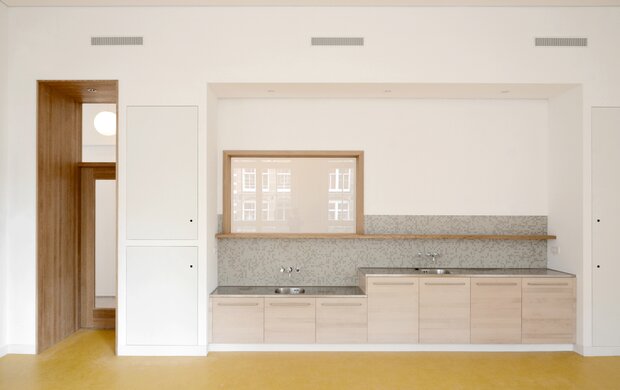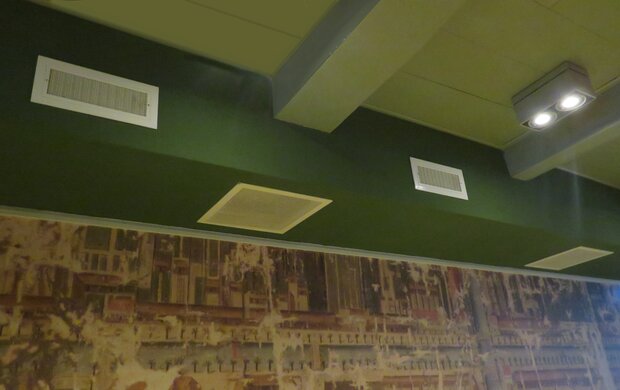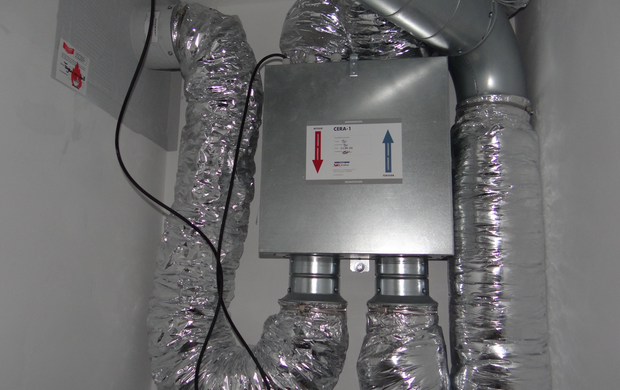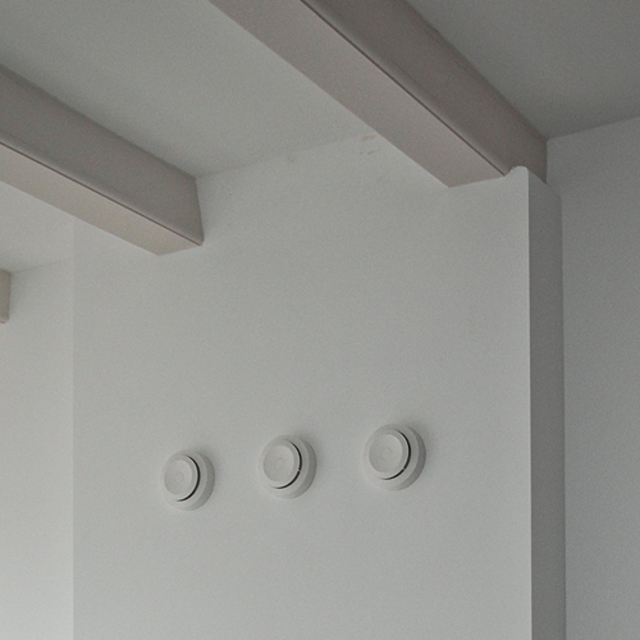Choose your municipality
There are several municipalities connected with The Green Menu, check whether your municipality is participating or choose for the national page.
Choose you menu card
There are several different menu cards. Choose a buildingtype down below and instantly start with the sustainable options!

Ventilation is very important for a building. Older buildings are ventilated automatically through seams and cracks. This way, the indoor climate and the moisture balance are kept in order in a natural way. But to avoid draughts and cold, we want to close these gaps. Possible consequences of this insulation are a poor indoor climate and wood rot, which can be prevented by proper ventilation. This can be done naturally and/or mechanically. There are also smart ways to recover heat from heated exhaust air. And did you know that dry ventilated air takes less energy to heat?
By insulating, the natural ventilation of the building disappears. There is no more natural supply because gaps and seams are closed. One possibility to supply air in a natural way is to install (insulated) ventilation grilles. This can be done in the facade or in combination with new windows. Consult with the municipality on which option will best suit the facade appearance. If it is not allowed to install grilles, it is an option not to close any gaps above 1.80 metres. At this height, you will have little to no draught, but fresh air will still enter the building.
Ventilation grilles can create draughts with strong winds. A solution is wind pressure controlled grilles, which automatically close or open more depending on the wind. This allows the grilles to remain open even with strong winds and reduces heat loss.
By insulating, the natural ventilation of the building disappears. There is no more natural supply because gaps and seams are closed. One possibility to supply air in a natural way is to install (insulated) ventilation grilles. This can be done in the facade or in combination with new windows. Consult with the municipality on which option will best suit the facade appearance. If it is not allowed to install grilles, it is an option not to close any gaps above 1.80 metres. At this height, you will have little to no draught, but fresh air will still enter the building.

In historical buildings, it is important to ventilate well to prevent moisture problems. This can be done through a combination of natural ventilation and mechanical ventilation. Have (insulated) ventilation grilles fitted for the supply of clean air. These ventilation grilles are available in various variants. For rooms such as the bathroom and kitchen, mechanical extraction can be used for ventilation. This requires ventilation ducts to be installed throughout the building. Make sure that no monumental parts are affected when installing the ducts.
There are various versions of supply air grilles, such as grilles with wind pressure controlled valves that prevent too much air from flowing onto the facade with strong winds. Electronically controlled valves also enable demand-driven ventilation with a CO2 and/or moisture sensor. This means there will only be ventilation when fresh air is needed. It is also possible to control the extraction per room in your house in a demand-driven way, so you can influence the ventilation supply and exhaust and thus save energy.
In historical buildings, it is important to ventilate well to prevent moisture problems. This can be done through a combination of natural ventilation and mechanical ventilation. Have (insulated) ventilation grilles fitted for the supply of clean air. These ventilation grilles are available in various variants. For rooms such as the bathroom and kitchen, mechanical extraction can be used for ventilation. This requires ventilation ducts to be installed throughout the building. Make sure that no monumental parts are affected when installing the ducts.
If ventilation ducts are not possible in your building, a decentralised ventilation system with heat recovery may be the solution. You can then install a facade ventilation unit in a room you often use. The ventilation unit regulates both the extraction of polluted air and the supply of clean air. Heat recovery ensures that the heat from the extracted air heats up the fresh air, so that heat is not lost and you save energy. The grilles for air extraction and supply are also available in brick format so that they are virtually invisible. The other rooms can be provided with natural ventilation through ventilation grilles. Toilet, shower and kitchen are separately extracted mechanically, which does require ducts.
If ventilation ducts are not possible in your building, a decentralised ventilation system with heat recovery may be the solution. You can then install a facade ventilation unit in a room you often use. The ventilation unit regulates both the extraction of polluted air and the supply of clean air. Heat recovery ensures that the heat from the extracted air heats up the fresh air, so that heat is not lost and you save energy. The grilles for air extraction and supply are also available in brick format so that they are virtually invisible. The other rooms can be provided with natural ventilation through ventilation grilles. Toilet, shower and kitchen are separately extracted mechanically, which does require ducts.

Good ventilation is important for healthy air in the building. A demand-driven ventilation system with smart sensors works efficiently. For instance, CO2 sensors detect the need for clean air in rooms such as the bedroom or living room. And in the bathroom or kitchen, humidity sensors measure humidity. The system only turns on if the CO2or humidity levels are too high. With the choice of a demand-driven ventilation system, fresh air is only supplied when needed.
Good ventilation is important for healthy air in the building. A demand-driven ventilation system with smart sensors works efficiently. For instance, CO2 sensors detect the need for clean air in rooms such as the bedroom or living room. And in the bathroom or kitchen, humidity sensors measure humidity. The system only turns on if the CO2or humidity levels are too high. With the choice of a demand-driven ventilation system, fresh air is only supplied when needed.

There are various options for ventilating your building. Balanced ventilation is a central system for ventilating the entire building. Fresh outside air is blown into the rooms via a duct system from a supply air box. And the exhaust air box, in turn, dissipates the 'used' air. In a heat recovery unit, the supply and exhaust air boxes are brought together so that heat is exchanged and energy is saved. A balanced ventilation system with CO2 and humidity sensors is efficient because no more fresh air is supplied than necessary.
Of course, heat recovery is not necessary in summer. A so-called ‘bypass’ can prevent it from becoming too hot indoors. This is an important point of attention when choosing a system.
There are various options for ventilating your building. Balanced ventilation is a central system for ventilating the entire building. Fresh outside air is blown into the rooms via a duct system from a supply air box. And the exhaust air box, in turn, dissipates the 'used' air. In a heat recovery unit, the supply and exhaust air boxes are brought together so that heat is exchanged and energy is saved. A balanced ventilation system with CO2 and humidity sensors is efficient because no more fresh air is supplied than necessary.

It is important that ventilation ducts are open and that the filters are clean. If filters are not clean, you will blow ‘dirty’ air into your building. In addition, a polluted (balanced) system has a lower capacity and consumes more electricity because of a higher resistance.